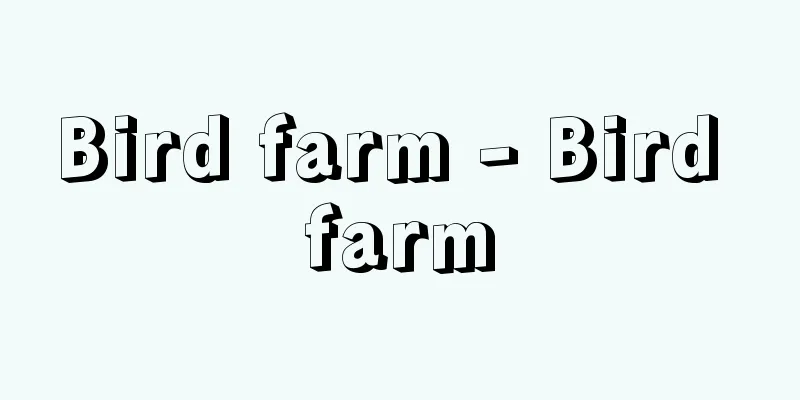Grassland - Sougen (English spelling)

|
A general term for various plant communities that are mainly herbaceous and lack woody plants or have only a few shrubs. In the narrow sense, it refers only to temperate grasslands such as steppes, prairies, Great Plains, and pampas, but in the broad sense, it includes grasslands that appear in cold regions where trees are difficult to grow, such as tropical savannas, tundra, and alpine grasslands, as well as artificially created grasslands such as pastures in Western Europe. Temperate grasslands are typical of grasslands and appear in so-called grassland climates (steppe climates). This climate does not have enough rainfall to support forests, but is not as dry as a desert. The border between humid regions and deserts is the dry limit, and half the annual precipitation of the dry limit (desert limit) is considered to be the border between temperate grasslands and humid regions. Temperate grasslands provide a large amount of humus from herbaceous plants, forming fertile soils (chernozem, prairie soil, chestnut soil). Although it has the disadvantages of low rainfall and a deep groundwater table, many parts of the world have been cultivated and become grain-producing regions, and many parts, such as the United States and Australia, have become commercial livestock farming areas. In comparison, land use in the tropical savanna, tundra, and alpine grasslands has lagged behind, and with some exceptions, they are only used for nomadic pastures. [Takehide Koizumi] Ecological grasslandsA community in which herbaceous plants grow densely and woody plants are scarce or absent. In many grassland communities, grassland communities are quantitatively dominated by grassland plants. They naturally occur in areas where forests do not normally form due to dryness or low temperatures. Temperate grasslands (steppes, prairies) spread across continental interiors in areas with cold winters and dry summers. Tropical grasslands (savannas), which contain a small number of trees, develop in tropical areas with a certain dry season. The combined area of both is about 24 million square kilometers, or about 16% of the land area. Grassland communities also occur in cooler areas (alpine grasslands) and overly humid areas (marshes). Even in forested climate regions, there are many artificial grasslands (pastures) and semi-artificially established and maintained grasslands. Mountain grasslands made of silver grass, bamboo grass, and turf grass found in the mountains and fields of Japan, and lowland grasslands made of reeds and sedge, are semi-natural grasslands maintained by mowing, livestock grazing, burning, etc. If left unattended, woody plants will invade and gradually turn into forests. Japan's natural grasslands include thorn grasslands (grasslands consisting of perennial broad-leaved herbs 2-3 meters tall) that develop on unstable wetlands in the subarctic and subalpine zones, alpine grasslands found in alpine zones, and high moors that develop on peat bogs made of sphagnum moss and other plants, but all of these are small in scale. The productivity of grasslands is lower than that of forests, with the amount of organic matter produced per square meter per year being an average of 600 grams in temperate grasslands, 900 grams in tropical grasslands, and 600-1,200 grams in Japanese Miscanthus grasslands. [Hideo Iwaki] FaunaThe various types of grasslands around the world each have their own unique fauna. Of these, the tropical and temperate grasslands are dominated by grasses, and the animals that feed on them and their predators form the fauna there. The most important herbivores are ungulates, and on all continents where ungulates live, they are the mainstay of the grasslands. In Africa, wildebeest (antelope), oryx, and zebras occupy their positions, while in the steppes of Eurasia, the rhinoceros antelope and the American bison occupy their positions, and in the prairies of North America, the horned antelope (formerly the American bison) occupy their positions. In Australia, where no ungulates live, the marsupial kangaroo takes over, and in South America, rodents such as the Pampas chubby take their place instead of ungulates. However, many of these grassland areas dominated by grasses are now used as pastures for livestock. In the cool-climate grasslands where cowberries are the main food source instead of grasses, ungulates such as reindeer and musk oxen still dominate. Important in the expansion of birds into grasslands are small grain-eating birds (weavers, buntings, etc.). In Japan's grasslands, there are only a few rodents such as voles, and no large herbivores. Insects are well known among the animals of Japanese grasslands, and 253 species of insects have been recorded in the riverside grasslands of the Tohoku region. Many of these insects, such as the armyworm and the cucumber beetle, feed on rice, and sometimes cause large outbreaks. [Hideyuki Osawa] [References] | | |Source: Shogakukan Encyclopedia Nipponica About Encyclopedia Nipponica Information | Legend |
|
草本を主体とし、木本植物を欠くかわずかに低木を交えるだけのさまざまの植物群落の総称。狭義にはステップやプレーリー、グレート・プレーンズ、パンパなど温帯草原のみをさすが、広義には熱帯のサバンナや、ツンドラ、高山草原など樹木の生育困難な寒冷地域に出現する草原、さらには西ヨーロッパの牧野のような人為的につくられた草原も含む。温帯草原は草原の代表的なもので、いわゆる草原気候(ステップ気候)下に出現する。これは、森林が成立するほどの雨量はないが、砂漠ほどは乾燥しないという気候で、湿潤地域とは乾燥限界、砂漠とは乾燥限界の年降水量の半分(砂漠限界)をもって境とされる。温帯草原では草本類から多量の腐植が供給されるため肥沃(ひよく)な土壌(チェルノゼム、プレーリー土、栗色(くりいろ)土)が形成されている。雨量が少なく、地下水面が深いという欠点はあるが、世界的には農耕地化されて穀倉地帯となっている所が多く、アメリカ合衆国やオーストラリアのように商業的な牧畜地帯となった所も多い。熱帯サバンナやツンドラ、高山草原は、これと比べると土地利用は遅れており、一部を除き遊牧に利用されているだけにすぎない。 [小泉武栄] 生態学上の草原草本植物が密生し、木本植物が少ないか、あるいはまったく存在しない群落。多くの草原群落ではイネ科草本植物が量的に優勢である。自然には、普通、乾燥や低温などのため森林が成立しないような地域に成立する。温帯草原(ステップ、プレーリー)は、大陸内部の冬が寒冷で夏に乾燥する地域に広がる。熱帯で一定の乾期をもつ地域には、多少の樹木を混生する熱帯草原(サバンナ)が発達する。両者の面積をあわせると約2400万平方キロメートル、陸地面積の約16%を占める。このほか、低温の地(高山草原)や過湿の地(湿原)にも草原群落は成立する。 森林気候の地域にも人工草原(牧草地)や、半人工的に成立し、維持される草原が多い。日本の山野にみられるススキ、ササ、シバなどのつくる山地草原、ヨシ、オギからなる低地草原は、草刈り、家畜の放牧、火入れなどによって維持される半自然草原である。これを放置すると木本植物が侵入し、しだいに森林に移り変わる。 日本の自然草原として、亜寒帯や亜高山帯の土壌が不安定な湿地に発達する高茎草原(高さ2~3メートルの多年生広葉草本からなる草原)、高山帯にみられる高山草原、ミズゴケなどの泥炭地に発達する高層湿原などがあるが、いずれも小規模である。 草原の生産力は森林に比べて低く、1平方メートル当りの1年間の有機物生産量をみると、温帯草原で平均600グラム、熱帯草原で平均900グラム、日本のススキ草原で600~1200グラムとなっている。 [岩城英夫] 動物相世界各地のさまざまなタイプの草原には、それぞれ特有の動物相が発達している。このうち熱帯草原と温帯草原はイネ科を主としたものであり、それらを主食とする動物とその捕食者がそこでの動物相を形成する。草食獣で重要なものは有蹄(ゆうてい)類であり、有蹄類の生息する大陸ではどこでも草原は有蹄類が中心となっている。アフリカではヌー(ウシカモシカ)やオリックス、シマウマが、ユーラシア大陸のステップではサイガレイヨウなどが、北アメリカのプレーリーではエダツノレイヨウ(かつてはアメリカバイソン)がその地位を占める。有蹄類の生息しないオーストラリアでは有袋類のカンガルーが、南アメリカではパンパスチャビーなどの齧歯(げっし)類が有蹄類のかわりの地位を占める。しかし、これらイネ科を中心とする草原の多くは、現在では家畜の放牧場となっている。イネ科のかわりにコケモモを主とする寒冷地草原では、トナカイやジャコウウシの有蹄類がやはり主力となっている。鳥類の草原への進出で重要なものは穀類食の小鳥(ハタオリドリ、ホオジロ類)である。 日本の草原には、ハタネズミなどの齧歯類がわずかにみられるだけで大形草食獣はいない。日本の草地の動物では昆虫類がよく知られており、東北地方の川辺の草地では253種の昆虫が記録されている。このなかにはアワヨトウ、ウリハムシモドキなど、イネを食害するものが多く、ときには大発生する。 [大澤秀行] [参照項目] | | |出典 小学館 日本大百科全書(ニッポニカ)日本大百科全書(ニッポニカ)について 情報 | 凡例 |
<<: Song and Yuan Dynasty Study Plan
Recommend
ATS (Satellite)
...Other medium altitude meteorological satellite...
Aphtha - Afuta (English spelling)
Aphthae are small, round or oval, very shallow ul...
Import of coal from overseas - Import of coal from overseas
...The basic principle of this was to review coal...
Uchino (Kyoto) - Uchino
…The fire destroyed the government offices in the...
Caryota urens (English spelling) Caryotaurens
…[Sumihiko Hatsushima]. … *Some of the terminolog...
Free Education Institute (English name)
A Spanish educational institution. It was founded ...
Fernando Álvarez de Toledo, Duke of Alba
Spanish soldier and politician. The third duke of...
Plagusia tuberculata (English spelling)
… [Takeda Masatomo]. … *Some of the terminology t...
Ogogo - Ogogo
…A local lord based in Ogogo, Seta County, Kozuke...
Corylus avellana (English spelling)
…[Hiroshi Aramata]. … From [Hazelnut] ...Two spec...
Long Live Iyo
Manzai is held in the Matsuyama area of Ehime P...
Answers to Correspondents
At the age of 16, he began writing for several Lo...
Louis XVII - Louis
Son of King Louis XVI of France. After the outbrea...
Kyushu Railway Company - Kyushu Railway Company
Established in 1987 following the division and pri...
Curtea de Argeş (English spelling)
A city in southern Romania. It is located in the s...









